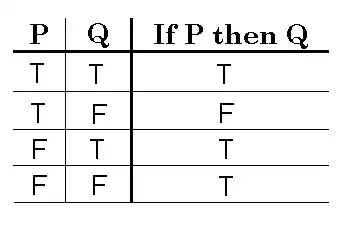Given the known theorems $P \Rightarrow Q$ and $\lnot P$, prove that we cannot deduce $\lnot Q.$
I made the truth table for $P \Rightarrow Q:$
Now, if $P \Rightarrow Q$ is a theorem, that means that we must exclude the second row of the truth table.
If $\lnot P$ is also a theorem, that means that $\lnot P$ is true, so $P$ must be false. Therefore, we must look in the last 2 rows of the truth table, since they're the only ones where $\lnot P$ and $P \Rightarrow Q$ are true at the same time.
I don't understand why we can't deduce $\lnot Q$ from $P \Rightarrow Q$ and $\lnot P.$ After all, if we are looking in the fourth row of the truth table where $P \Rightarrow Q$ is true and $\lnot P$ is true, then$\lnot Q$ is also true.
